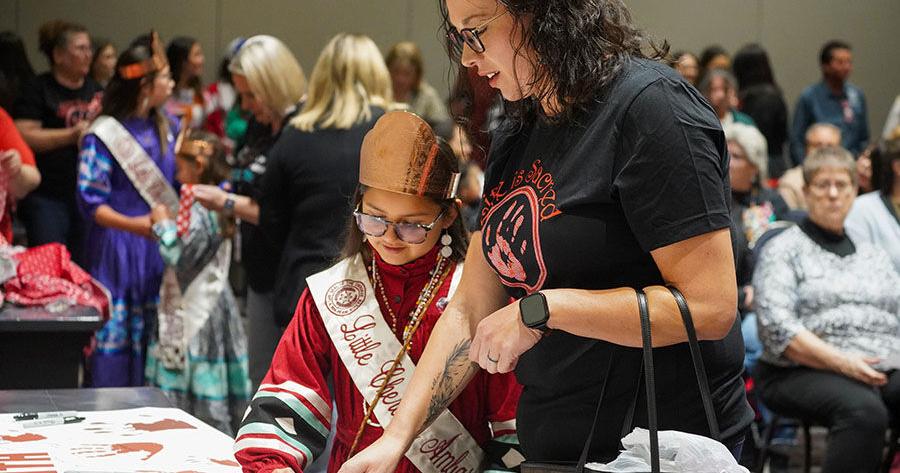TAHLEQUAH – As May comes to an end, the Missing or Murdered Indigenous Persons crisis in Indian Country does not.
May, which was declared as MMIP Month within the Cherokee Nation, is a reminder of those whose stories were cut short. It also gives way for exposure and education to help one of the tribe’s most vulnerable population – children and young adults.

A Cherokee Nation marshal adds his name to a Missing or Murdered Indigenous Persons Awareness Month banner during the tribe’s May 2 Missing or Murdered Indigenous Persons Awareness Month proclamation signing. The Marshal Service plans to provide MMIP educational opportunities in Cherokee communities, something the entity is currently working on.
“MMIP and trafficking are very much out there,” Shawna Roach, Cherokee Nation Marshal Service investigator, said. “Perpetrators prey on those who are not aware of the signs to look for, so we, as the Cherokee Nation Marshal Service, need to provide that awareness for communities.”
The Marshal Service plans to do this by providing educational opportunities in Cherokee communities, something the entity is currently working on.
“The primary goal is to educate communities and conduct in-person events about missing persons to increase awareness and facilitate proactive actions to help locate missing individuals,” Roach said.
Roach pointed out that oftentimes, the acts stem from social media, and predators often target rural areas.
“The real problem is not the communities, a lot of the issues are the use of social media today,” Roach said. “Understanding how predators work is what needs to be taught to the families, schools and everyone who utilizes social media – Facebook, Instagram, Snapchat and more.”

Cherokee Nation citizen Pam Smith and Cherokee Nation Principal Chief Chuck Hoskin Jr. speak before the tribe’s May 2 Missing or Murdered Indigenous Persons Awareness Month proclamation signing. In the background sits a photo of CN citizen Aubrey Dameron, who is Smith’s niece. Dameron went missing on March 9, 2019. Her remains were found in the Picher-Cardin area in northeastern Oklahoma on Jan. 31, 2025, and identified on Feb. 5.
In the case of a missing juvenile, Roach suggests parents or guardians be aware of what apps children are using.
“The parents are sometimes unaware of who the juvenile is in contact with on social media,” she said.
On the other hand, Roach said social media can also be used as a tool in the event of someone going missing.
“When dealing with a case of a missing person, the main goal is to get the information out to the public as quickly as possible. The communities are very beneficial for working on these cases, along with social media. Utilizing social media definitely helps to receive information that can be vital to the case.”
Another CN department that provides education and resources regarding the MMIP crisis is ONE FIRE.
Patricia Kidwell Mancillas, ONE FIRE senior director, said the department stresses the importance of being aware of surroundings, limiting online exposure and maintaining trusted contacts.
“One of the most important things to remember is that MMIP is not just a statistic, it affects real families and real communities,” she said. “Cherokee Nation ONE FIRE remains steadfast in its mission to protect, educate and advocate for our people because every voice matters, every life is sacred, and no one should be forgotten.”
While the tribe is continuing to put a spotlight on its citizens, Roach said the number of missing and murdered Indigenous persons will never truly be known.
“But we can correct the course for the future and for our families,” Roach said. “We can make it better by reducing MMIP rates and do that by education and heightened awareness for communities and schools.”
Roach said according to the National Missing and Unidentified Persons System, or NAMUS, there are approximately seven missing Cherokee Nation citizens. That number includes juveniles as well as adults.
“Being cross-deputized with more than 100 plus agencies, those numbers could be larger. The reason is that those agencies will conduct their own investigation,” Roach said. “I am currently working with a task force and reaching out to agencies requesting to receive any information on missing juveniles or adults within the Cherokee Nation Reservation that is currently active.”
Roach said NAMUS – which can be used by anyone to search or enter information – as well as local grassroots organizations such as NOISE and Native Hope have helped law enforcement gather more information on MMIP cases.
During the tribe’s proclamation signing declaring May as Missing and Murdered Indigenous Persons Awareness Month, CN Marshal Service Acting Marshal Daniel Mead spoke about the development of a QR code system to help those experiencing potential dangers.
The QR code will be on posters placed in restrooms in high-risk locations throughout the reservation.
“So, if a person is able to break away just to even say, ‘I need to use the restroom,’ then get in there and … have a QR code that sends text messages directly to our dispatch,” he said. “We’ll know exactly where they’re at, and they’ll be able to talk to them through text messages.”
For those in need of assistance through ONE FIRE, contact 918-772-4260 or email one-fire@cherokee.org.

